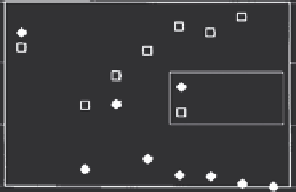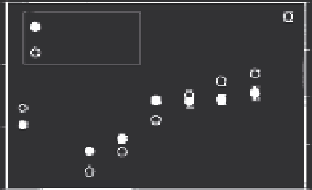Biomedical Engineering Reference
In-Depth Information
actual field strength and so numerical techniques or direct mea-
surement should be used to characterize the field distribution
in a coil. The alternating field is applied and the temperature of
the sample can be monitored through a temperature probe. The
SAR can then be estimated through the rate of temperature rise
method (Chou 1990). Another type of field generator more rel-
evant to the clinical setting will be discussed in Section 17.5.1.4.
route for producing magnetic nanoparticle structures, and
iron oxide has been the magnetic material of choice for
in vivo
applications, due to its well-documented biocompatibility and
metabolic pathways (Weissleder et al. 1989).
Coprecipitation and thermal decomposition are the preferred
methods for synthesizing iron oxide nanoparticles, owing largely
to good control over nanoparticle size, a large literature base
supporting process development, and high economic viability
(Lu, Salabas, and Schüth 2007; Krishnan 2010). Coprecipitation
involves an aqueous solution reaction between an Fe
2+
/Fe
3+
salt
and a base under an inert atmosphere. Reactions can take place
at room or elevated temperatures. Coprecipitation methods can
produce large quantities of nanoparticles with highly reproduc-
ible quality once the kinetic synthesis parameters have been set,
including ionic ratios, reaction temperatures, and solution pH.
Thermal decomposition involves decomposition of organome-
tallic compounds in high temperature organic solvents, contain-
ing stabilizing surfactants. Common surfactants include oleic
acid, fatty acids, and hexadecylamine. Resulting nanoparticle
properties, size, and polydispersity are largely determined by the
ratios of reactants and surfactants, reaction temperature, reac-
tion time, and aging period.
Although coprecipitation and thermal decomposition methods
can be used to synthesize highly reproducible nanoparticle popula-
tions, these populations often demonstrate notable polydispersity,
and as discussed in previous sections, this can have a significant
impact on relaxation behavior and heating. Some common meth-
ods exist for reducing polydispersity based purely on size and
density, but a preferred method for magnetic fluids is magnetic
fractionation (Jordan et al. 2003). In magnetic fractionation, the
aqueous nanoparticle solution is poured through a column under a
high, static magnetic flux and washed with deionized water until the
washout is clear. The magnetic flux can then be decreased in a step-
wise manner down to zero, performing a similar washout at each
increment, ideally producing nanoparticle fractions with increas-
ing magnetism. This technique was demonstrated on dextran
coated, superparamagnetic iron oxide in a field decreasing from
1100 mT, with results included in Figure 17.7. Two fractions were
taken at the highest field. A clear increase in the specific saturation
17.3 Synthesis and Modification of
Iron Oxide Nanoparticles
Elucidating the theory behind magnetic nanoparticle heating
highlights the factors that are important for engineering opti-
mization of nanoparticle systems, but it is the methods of syn-
thesis and resulting nanoparticle constructions that ultimately
determine the physicochemical and physiological behavior.
Bare particles do not generally demonstrate stability or physio-
logical compatibility without surface modification. Core-shell
structures are critical for providing viable in vivo application.
Considerations regarding different core-shell structures and
methods of synthesis will be discussed in the following section.
More comprehensive reviews of magnetic nanoparticle synthe-
sis and surface modification have been provided by Gupta et
al. (Gupta and Gupta 2005), Lu et al. (Lu, Salabas, and Schüth
2007), and Krishnan (Krishnan 2010).
17.3.1 Synthesis and Core-Shell Structures
Synthesis of magnetic nanoparticles for
in vivo
biomedical
applications requires well-controlled processes that can reli-
ably provide particles with well-defined size distributions,
consistent magnetic properties, good structural and chemical
stability under physiological conditions, and high biocompat-
ibility. Although the particles' magnetic behavior is largely
determined by the metallic or metallic-oxide core, this core
must be functionalized with a coating (and/or shell) that deter-
mines subsequent interactions in solution and in biological
systems. Chemical synthesis methods have been the dominant
12
6
15
80
Core radius
60
Particle radius
8
4
10
Iron amount
40
Magnetization
4
2
5
20
0
0
0
0
Fraction (mT)
Fraction (mT)
(a)
(b)
FIGURE 17.7
Iron concentration (a) and radius distributions (b) created by magnetic fractionation technique. (From Jordan, A. et al.,
Journal of
Nanoparticle Research
5, 5, 2003.)


